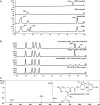A [3Fe-4S] cluster and tRNA-dependent aminoacyltransferase BlsK in the biosynthesis of Blasticidin S
- PMID: 34282016
- PMCID: PMC8325364
- DOI: 10.1073/pnas.2102318118
A [3Fe-4S] cluster and tRNA-dependent aminoacyltransferase BlsK in the biosynthesis of Blasticidin S
Abstract
Blasticidin S is a peptidyl nucleoside antibiotic. Its biosynthesis involves a cryptic leucylation and two leucylated intermediates, LDBS and LBS, have been found in previous studies. Leucylation has been proposed to be a new self-resistance mechanism during blasticidin S biosynthesis, and the leucyl group was found to be important for the methylation of β-amino group of the arginine side chain. However, the responsible enzyme and its associated mechanism of the leucyl transfer process remain to be elucidated. Here, we report results investigating the leucyl transfer step forming the intermediate LDBS in blasticidin biosynthesis. A hypothetical protein, BlsK, has been characterized by genetic and in vitro biochemical experiments. This enzyme catalyzes the leucyl transfer from leucyl-transfer RNA (leucyl-tRNA) to the β-amino group on the arginine side chain of DBS. Furthermore, BlsK was found to contain an iron-sulfur cluster that is necessary for activity. These findings provide an example of an iron-sulfur protein that catalyzes an aminoacyl-tRNA (aa-tRNA)-dependent amide bond formation in a natural product biosynthetic pathway.
Keywords: iron–sulfur cluster; leucyl transfer reaction; natural product; tRNA-dependent enzymes.
Conflict of interest statement
The authors declare no competing interest.
Figures







Similar articles
-
tRNA-dependent peptide bond formation by the transferase PacB in biosynthesis of the pacidamycin group of pentapeptidyl nucleoside antibiotics.Proc Natl Acad Sci U S A. 2011 Jul 26;108(30):12249-53. doi: 10.1073/pnas.1109539108. Epub 2011 Jul 11. Proc Natl Acad Sci U S A. 2011. PMID: 21746899 Free PMC article.
-
Guanidine N-methylation by BlsL Is Dependent on Acylation of Beta-amine Arginine in the Biosynthesis of Blasticidin S.Front Microbiol. 2017 Aug 22;8:1565. doi: 10.3389/fmicb.2017.01565. eCollection 2017. Front Microbiol. 2017. PMID: 28878744 Free PMC article.
-
Investigation of Amide Bond Formation during Dehydrophos Biosynthesis.ACS Chem Biol. 2018 Mar 16;13(3):537-541. doi: 10.1021/acschembio.7b00949. Epub 2018 Jan 12. ACS Chem Biol. 2018. PMID: 29303545 Free PMC article.
-
Aminoacyl-tRNA-Utilizing Enzymes in Natural Product Biosynthesis.Chem Rev. 2017 Apr 26;117(8):5578-5618. doi: 10.1021/acs.chemrev.6b00523. Epub 2017 Jan 6. Chem Rev. 2017. PMID: 28060488 Review.
-
Biosynthesis of Sulfur-Containing tRNA Modifications: A Comparison of Bacterial, Archaeal, and Eukaryotic Pathways.Biomolecules. 2017 Mar 11;7(1):27. doi: 10.3390/biom7010027. Biomolecules. 2017. PMID: 28287455 Free PMC article. Review.
Cited by
-
Research progress in the role and mechanism of Leucine in regulating animal growth and development.Front Physiol. 2023 Nov 17;14:1252089. doi: 10.3389/fphys.2023.1252089. eCollection 2023. Front Physiol. 2023. PMID: 38046946 Free PMC article. Review.
-
Radical S-Adenosyl Methionine Enzyme BlsE Catalyzes a Radical-Mediated 1,2-Diol Dehydration during the Biosynthesis of Blasticidin S.J Am Chem Soc. 2022 Mar 16;144(10):4478-4486. doi: 10.1021/jacs.1c12010. Epub 2022 Mar 3. J Am Chem Soc. 2022. PMID: 35238201 Free PMC article.
-
Blasticidin S Biosynthesis Involves a Unique Interplay between a Radical SAM Dehydratase, a Transaminase and an ATP-Grasp Ligase in Order to Avoid a Futile Cycle.ACS Catal. 2025 Feb 21;15(4):2742-2749. doi: 10.1021/acscatal.4c07051. Epub 2025 Jan 30. ACS Catal. 2025. PMID: 40822989 Free PMC article.
References
-
- Schimmel P., The emerging complexity of the tRNA world: Mammalian tRNAs beyond protein synthesis. Nat. Rev. Mol. Cell Biol. 19, 45–58 (2018). - PubMed
-
- Moutiez M., Belin P., Gondry M., Aminoacyl-tRNA-utilizing enzymes in natural product biosynthesis. Chem. Rev. 117, 5578–5618 (2017). - PubMed
-
- Fonvielle M., et al. ., The structure of FemX(Wv) in complex with a peptidyl-RNA conjugate: Mechanism of aminoacyl transfer from Ala-tRNA(Ala) to peptidoglycan precursors. Angew. Chem. Int. Ed. Engl. 52, 7278–7281 (2013). - PubMed
Publication types
MeSH terms
Substances
Supplementary concepts
LinkOut - more resources
Full Text Sources
Molecular Biology Databases

